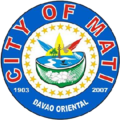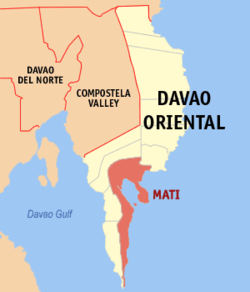Top Qs
Timeline
Chat
Perspective
Mati, Davao Oriental
Capital of Davao Oriental, Philippines From Wikipedia, the free encyclopedia
Remove ads
Mati, officially the City of Mati (Cebuano: Dakbayan sa Mati; Filipino: Lungsod ng Mati, is a component city[3] and capital of the province of Davao Oriental, Philippines located on the southeasternmost side of Mindanao.
Remove ads
History
Summarize
Perspective
Mati comes from the Mandaya word Maa-ti, which refers to the town's creek that easily dries up even after heavy rain. Pioneer settlers were the Austronesian indigenous peoples Mandaya and Kalagan, and the Arabic-Indo-Malayan-influenced Maguindanao and Maranao.
Spanish period
Captain Prudencio Garcia, the pioneer political-military head in 1861, and his comrade Juan Nazareno founded the settlement of Mati and two other communities in Davao Oriental.[4]
American period
By October 29, 1903, Mati was declared a municipality by virtue of Act No. 21.[4] By 1907, Act No. 189 further reaffirmed the establishment of its local government. Francisco Rojas was the first appointed mayor while the first elected mayor was Patricio Cunanan in 1923. Mati became the capital of Davao Oriental in 1967.
Japanese occupation and World War II
The Japanese Imperial forces landed in town and occupied most of eastern Davao region in 1942. Mati was liberated in 1945 by the Allied Philippine Commonwealth troops of the 6th, 10th, 101st, 102nd, 103rd, 104th, 106th, 107th and 110th Infantry Division of the Philippine Commonwealth Army, 10th Infantry Regiment of the Philippine Constabulary and the Davaoeño guerrilla units.
Third Republic
In 1970, Mayor Thelma Z. Almario received the Outstanding Mayor of the Philippines award.[5] In 1972, Mayor Almario founded the Mati Community College, which was later converted into the Davao Oriental State College of Science and Technology (now the Davao Oriental State University) in December 1989 based on Republic Act No. 6807 which she wrote as a member of Congress.[6]
Contemporary period
Mati celebrated the grand centennial of its founding as a town in 2003.[7]
Cityhood
On June 20, 2007, the Commission on Elections officially proclaimed the ratification of Republic Act 9408 converting the Municipality of Mati into a component city.
There were 18,267 actual voters out of the 51,287 registered voters in 26 villages and 266 polling precincts during the June 18 plebiscite. Final tabulation showed Yes – 18,267 votes (35.6%); No – 846 (1.6%).[8]
The Supreme Court declared the cityhood law of Mati and 15 other cities unconstitutional after a petition filed by the League of Cities of the Philippines in its ruling on November 18, 2008. On December 22, 2009, the cityhood law of Mati and 15 other municipalities regain its status as cities again after the court reversed its ruling on November 18, 2008. On August 23, 2010, the court reinstated its ruling on November 18, 2008, causing Mati and 15 cities to become regular municipalities. Finally, on February 15, 2011, Mati becomes a city again including the 15 municipalities declaring that the conversion to cityhood met all legal requirements.
After six years of legal battle, in its board resolution, the League of Cities of the Philippines acknowledged and recognized the cityhood of Mati and 15 other cities.
Barangays
Mati is politically subdivided into 26 barangays. Each barangay consists of puroks while some have sitios.
In 1957, the barrio then known as Cabuaya was renamed to Dawan.[9]
- Badas
- Bobon
- Buso
- Cabuaya
- Central (City Proper)
- Culian
- Dahican
- Danao
- Dawan
- Don Enrique Lopez
- Don Martin Marundan
- Don Salvador Lopez, Sr.
- Langka
- Lawigan
- Libudon
- Luban
- Macambol
- Mamali
- Matiao
- Mayo
- Sainz
- Sanghay
- Tagabakid
- Tagbinonga
- Taguibo
- Tamisan
Climate
Mati features a tropical rainforest climate with copious amounts of rainfall throughout the course of the year. There is no pronounced dry season, but it has very pronounced maximum rain from May to July, with June being the wettest month of the year, experiencing 28 days of rain.
Remove ads
Demographics
Ethnicity and languages
Cebuano is the most widely spoken language and the corresponding ethnicity (which includes the Boholano subgroup) accounts for 71.55% of the total household population according to a 2000 census. Mandaya ranks second with 12.74%, followed by Kalagan with 6.87%. In addition, the Mati dialect of the Northern Sama is also used by the sea gypsy population in the coastal areas.[14] Most residents of Mati are descendants of migrants from the Visayas who came for employment opportunities in logging, mining, farming, fishing, trading and teaching.[15]
Remove ads
Economy
Main produce from the city is coconut.
References
External links
Wikiwand - on
Seamless Wikipedia browsing. On steroids.
Remove ads





